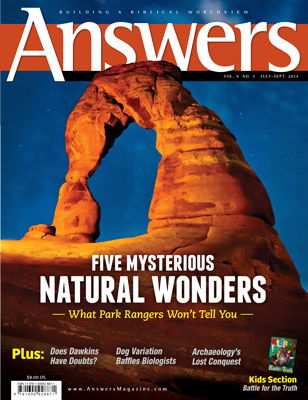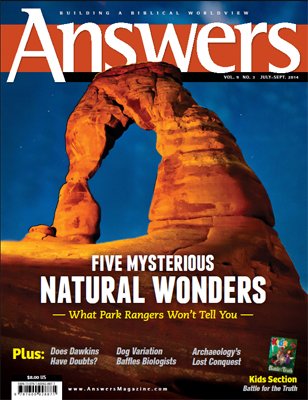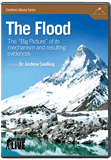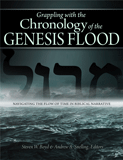Rapid Opals in the Outback
Only one place on Earth holds a treasure trove of precious opals—Australia’s Outback. Far from requiring millions of years, the unique conditions necessary to produce these beauties point to the Flood.
Precious opal, with its dazzling display of brilliant blues, greens, yellows, and fiery reds, is one of the most recognizable Australian icons. More than 95 percent of the world’s opals are mined in this one country, explaining why it is the national gemstone. In fact, most gem-quality opals come from one locale in Australia—the Great Artesian Basin.
So what is so unique about Australia’s Great Artesian Basin that it produces so many precious opals? The answer is revealing because it hints at unique circumstances that dovetail perfectly with the closing stages of the global cataclysmic Flood recorded in Genesis 7–8.
Opals point to the special conditions in Australia at the end of the Flood.
It is also revealing to see how quickly opals can form. Laboratories can “grow” them within weeks using the right ingredients.1 When such experiments grow opals within the same kind of rock material that contains natural opals, the rapidly grown opal is virtually identical to the natural stones. Furthermore, commercial production of high-quality imitation opals has flooded the market, and these gems, too, are often difficult to distinguish from natural opals.2
The ease of making opals—and their limited locale—points to the special conditions in Australia at the end of the Flood.
What Are Opals?
Opal is made out of silica, known in chemical terms as silicon dioxide (SiO2). When this chemical compound crystallizes, it forms the common mineral known as quartz, found all over the Earth; in its manmade form, this material is window glass. But opals aren’t crystallized like quartz, and unlike quartz they have a high water content, usually 6–10 percent. This indicates that a different process formed the opals than quartz.
Precious opal does have some structure, however. It is made of a regular three-dimensional array of uniformly sized silica spheres. When light passes through these orderly packed spheres, it diffracts and produces mesmerizing colors.3 Common opal, unlike precious opal, does not have this structure, so it is generally milky white or gray with a waxy, translucent sheen. Nothing colorful here.
Most quartz crystals were forged in relatively high temperatures and pressures—common conditions throughout the upper crust during the Flood. The less-structured opals, however, required a rarer, cooler setting, near the Earth’s surface.
Where Are Precious Opals Found and Formed?
With the exception of one location, all Australian precious opals are found at the same relative levels within 164 feet (50 m) of the ground surface. These deeply weathered layers are Lower Cretaceous sedimentary rocks located in the Great Artesian Basin.4 In fact, miners discovered a plesiosaur (sea creature) whose bones had turned to opal!
The most productive mines in the basin are located at the edge, mainly at Coober Pedy and Andamooka (see map). Many famous white (or milky) opals were found here, such as the Queen’s Opal (or the Andamooka Opal), given to Queen Elizabeth II in 1954. The largest known opal came from Coober Pedy—the Olympic Australis, weighing in at a whopping 17,000 carats (7.6 pounds)! Other precious opal mines dot the Winton Formation in the interior of the basin, such as the mines at Lightning Ridge, which produce prized black opals.
At the time these sediments were deposited, a huge basin, or “bowl” sat in the center of Australia. Water from the ocean flooded into this region, becoming a shallow extension of the deep sea. To the east on the edge of the Australian continent, huge volcanoes were belching out copious quantities of volcanic ash.5 Much of this volcanic ash mingled with fragments of mineral feldspar, organic debris, and pyrite (iron sulfide, FeS2), as these sedimentary layers were deposited across the Great Artesian Basin (Figures 1–2).
Following deposition of these layers, the center of the continent uplifted, causing sea waters to rush off the continent and erode the recently laid sediments. Intense drying out of the landscape followed (conventional geology suggests a desert, but Genesis 8:1–14 suggests another option). The climate was relatively cold in the interior of this southerly continent, and deep weathering occurred.6 A unique environmental interplay then formed the precious opals (Figure 3).7
In the Right Place at the Right Time
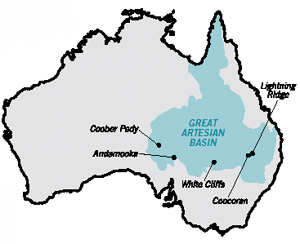
Australia experienced a unique combination of circumstances that allowed gem-quality opals to form in abundance, unlike any other place on Earth. This took place during the Flood when a shallow “bowl” formed in the interior, known as the Great Artesian Basin. It is now ringed with rich opal mines.
First, Massive Sediments Were Laid with a Mix of Special Ingredients
During the Flood, a shallow sea formed in the Artesian Basin, where the floodwaters dumped a special combination of iron-rich and organic sediments.

Second, Volcanic Ash Was Mixed with the Top Layer of Sediments
As the Flood deposited its final sediments in the Artesian Basin, an arc of volcanoes belched ash into the shallow sea, which mixed with the sediments, which included pyrite, feldspar, and organic debris.

Third, the Layers Were Lifted Up, Dried, and Weathered Quickly
A complicated sequence of chemical reactions then occurred. First, water percolated down and reacted with the pyrite, making the water acidic. This acidic water then reacted with the feldspar to release the silica (the basic ingredient in opals).
Conditions around 164 feet (50 m) became just right (alkaline, not acidic) for the minerals to break down further. The silica could precipitate as precious opal (*) only in tight spaces, such as along fractures and faults.

The sequence of events and chemical reactions necessary to form opal gets quite complicated. But here is a summary. First, as surface water percolated deep downward through porous sandstones and faults, oxygen reacted with the pyrite in the sedimentary layers. As a result, the water became acidic. Then the acidic groundwater reacted with the feldspar and volcanic ash to produce a clay mineral known as kaolinite, along with sulfate minerals and silica.
The minerals trapped in the confined spaces, fractures, and faults began to break down. Something very significant happened at the water level where the chemical conditions became alkaline (not acidic), around 164 feet (50 m) deep: further mineral breakdowns left iron oxides and even more silica, which precipitated as precious opal.
In summary, the formation of precious opal required a unique combination of conditions. First it needed sediments that contained silica. Then it needed a chemical environment with strong acidic conditions to release the silica. Yet this silica had to appear in confined places so the acid and base could react (called neutralization) to produce the solid gems (by precipitation). This final step could occur only under alkaline conditions, as opposed to the acidic conditions that prevailed earlier. Without the final alkaline conditions, only common opal is formed. What a rare combination of events!
Chemical “fingerprinting” of opals has confirmed that the Great Artesian Basin provided all these conditions—in the necessary sequence. The different precious opal deposits have different trace elements, depending on the local sediments where they came from. Other trace elements in the opals reflect the volcanic ash that later became part of the gems.8
How could the Flood explain all these events? Massive sediments were deposited, with copious amounts of volcanic debris mixed into them, followed by a period of intense drying out and weathering. At the same time, all the right conditions at the right time had to be met to rearrange various chemical compounds in the weathered rock layers to produce Australia’s precious opals.
Where Does Opal Formation Fit in the Flood Account?
In Genesis 7:17–24 God records that Flood waters rose and prevailed across the entire face of the globe, covering all the mountains and wiping out all life on land by Day 150 at the latest.9 Then Genesis 8:1 describes God sending a wind so that the waters started to abate and decrease. By Day 315 the ground was dry, and 56 days later Noah and the animals disembarked from the Ark (Genesis 8:13–14).
From what may be gleaned from the sedimentary layers of the rock record, it appears that the Earth’s sea level rose and peaked during the laying of the first Flood deposits (the Cambrian). The ocean then fluctuated up and down until the final deposits were laid, reaching the last peak when the Upper Cretaceous layers (highest dinosaur layers) were laid.10 Thus it seems possible that the water level peaked for the last time when these deposits were laid, around Day 150 of the Flood. This certainly makes sense of the wiping out of the last dinosaurs outside the Ark, as they scrambled to find a safe place to survive the rising waters and left footprints in the Winton Formation (among the main Cretaceous deposits where opals are now found).11
None of these events required millions of years, as modern experiments confirm.
The Flood waters then retreated from off the Australian continent, leaving the ground to dry out and intensely weather. During this intense drying phase at the very end of the Flood the unique combination of materials and environmental and chemical conditions produced the precious opals. None of these events required millions of years, as modern experiments confirm.
God’s Colorful Reminders
In Joshua 4:20–23 God used a pile of stones from the Jordan River to remind His people how God delivered them through that river’s flood. Similarly, there can be no doubt that God has left the rock and fossil records as a potent reminder of His Flood judgment on the rebels of Noah’s day and His deliverance of His people (2 Peter 3:5–7).
The same rock record that speaks of judgment also contains colorful gems produced as a result of the Flood judgment. These remind us that even in judgment God is able to create exquisite beauty, just as His Spirit can turn wretched sinners into gems of His grace by the atoning work of His Son, the Creator and the Lord Jesus Christ.
Answers Magazine
July – September 2014
The summer issue looks at some of the earth’s most amazing rock features and explains how they formed quickly in the past few thousands of years.
Browse IssueFootnotes
- A. A. Snelling, “Growing Opals—Australian Style,” Creation Ex Nihilo 12.1 (December 1989–February 1990): 10–15; A. A. Snelling, “Creating Opals—Opals in Months, not Millions of Years,” Creation 17.1 (December 1994– February 1995): 14–17.
- A. Smallwood, “35 Years On: A New Look at Synthetic Opal,” The Australian Gemmologist 21 (2003): 438–447.
- J. V. Sanders, “Colour of Precious Opal,” Nature 204 (1964): 1151–1153; J. V. Sanders, “Diffraction of Light by Opals,” Acta Crystallographica A24 (1968): 427–434; P. J. Darragh, A. J. Gaskin, and J. V. Sanders, “Opals,” Scientific American 234 (1976); 84–95.
- P. F. Rey, “Opalisation of the Great Artesian Basin (Central Australia): An Australian Story with a Martian Twist,” Australian Journal of Earth Sciences 60 (2013): 291–314.
- S. E. Bryan, A. E. Constantine, C. J. Stephens, A. Ewart, R. W. Schön, and J. Parianos, “Early Cretaceous Volcano-Sedimentary Successions along the Eastern Australian Continental Margin: Implications for the Break-up of Eastern Gondwana,” Earth and Planetary Science Letters 153 (1997): 85–102; S. E. Bryan, A. Ewart, C. J. Stephens, J. Parianos, and P. J. Downes, “The Whitsunday Volcanic Province, Central Queensland, Australia: Lithological and Stratigraphic Investigations of a Silicic-Dominated Large Igneous Province,” Journal of Volcanology and Geothermal Research 99 (2000): 55–78.
- M. I. Bird and A. R. Chivas, “Geomorphic and Palaeoclimatic Implications of an Oxygen-Isotope Chronology for Australian Deeply Weathered Profiles,” Australian Journal of Earth Sciences 40 (1993): 345–358.
- Ref. 4.
- A. Dutkiewicz, T. C. Landgrebe, and P. F. Rey, “Origin of Silica and Fingerprinting of Australian Sedimentary Opals,” Gondwana Research 26 (2014): http://dx.doi.org/10.1016/j.gr.2013.10.013.
- Perhaps even as early as Day 40. See: L. A. Anderson, Jr., “A Deeper Understanding of the Flood: Details Matter,” Answers 9.2 (April–June 2014): 60–63.
- A. A. Snelling, “Geological Issues: Charting a Scheme for Correlating the Rock Layers with the Biblical Record,” in Grappling with the Chronology of the Genesis Flood, eds. S. W. Boyd and A. A. Snelling (Green Forest, Arkansas: Master Books, 2014), pp. 77–109.
- A. Romilio, R. T. Tucker, and S. W. Salisbury, “Reevaluation of the Lark Quarry Dinosaur Tracksite (Late Albian–Cenomanian Winton Formation, Central Western Queensland, Australia): No Longer a Stampede?” Journal of Vertebrate Paleontology 33:1 (2013): 102–120; R. A. Thulborn, “Lark Quarry Revisited: A Critique of Methods Used to Identify a Large Dinosaurian Track-maker in the Winton Formation (Albian–Cenomanian), Western Queensland, Australia,” Alcheringa 37.3 (2013): 312–330.
Recommended Resources

Answers in Genesis is an apologetics ministry, dedicated to helping Christians defend their faith and proclaim the good news of Jesus Christ.
- Customer Service 800.778.3390
- Available Monday–Friday | 9 AM–5 PM ET
- © 2025 Answers in Genesis



